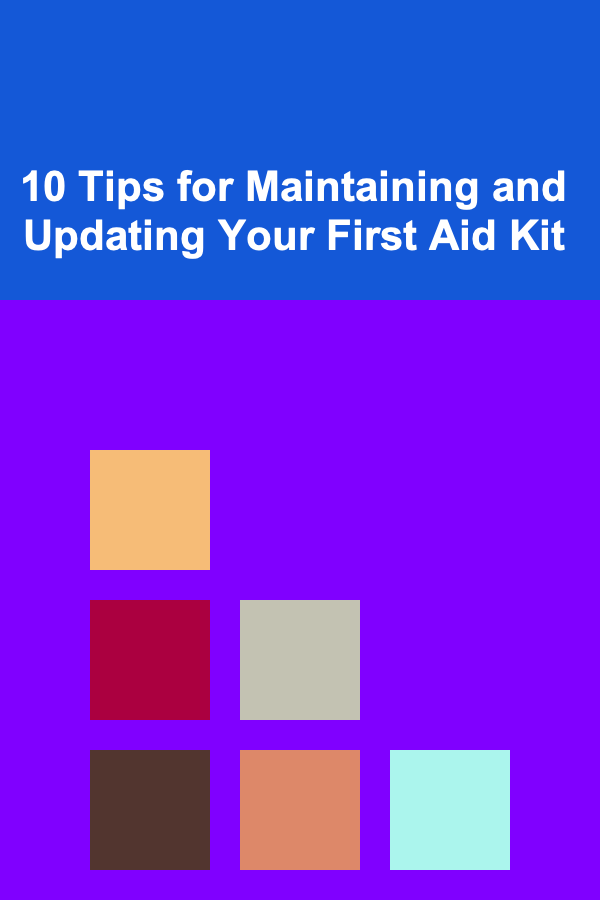
10 Tips for Maintaining and Updating Your First Aid Kit
ebook include PDF & Audio bundle (Micro Guide)
$12.99$9.99
Limited Time Offer! Order within the next:

A first aid kit is an essential item that can save lives in emergencies, providing immediate care until professional help arrives. However, owning a first aid kit is not enough. It's crucial to ensure that your kit is always fully stocked, well-organized, and up to date. Over time, supplies can expire, and your needs might change. Regular maintenance and updates are essential for making sure your first aid kit can perform when you need it most.
This article explores 10 practical tips to help you maintain and update your first aid kit effectively. These tips will guide you in keeping your first aid supplies in top condition, ensuring that you're ready for any emergency.
Regularly Check the Expiration Dates
First aid supplies have limited shelf lives, especially medications and antiseptics. Over time, items like adhesive bandages, gauze, and even pain relief tablets can expire, losing their effectiveness. It's crucial to regularly check the expiration dates of all items in your first aid kit to ensure that they're still viable.
What to Check:
- Medications: Most medications in your first aid kit, such as painkillers, antiseptic creams, and ointments, will have expiration dates. Even if they are still sealed, expired medications can lose their potency or may cause harm.
- Bandages and Dressings: Bandages, gauze, and adhesive strips can deteriorate over time, making them less effective in providing protection. Check for signs of wear or peeling.
- Antiseptics and Alcohol Pads: These products can lose their disinfecting power after the expiration date. Replacing them regularly ensures effective cleansing and sterilization.
Set a routine reminder, such as every six months, to check the contents of your first aid kit. Replace expired or damaged items immediately to maintain the kit's integrity.
Replenish Supplies After Use
Whenever you use an item from your first aid kit, be sure to replace it as soon as possible. Having an item missing in an emergency can delay care and potentially worsen the situation. After a medical incident, take inventory of what you've used, and promptly replace the supplies so that your kit is always ready for the next emergency.
Commonly Used Items to Replenish:
- Bandages: Bandages, both small and large, are frequently used. Ensure you have a variety of sizes for different injuries.
- Sterile Gauze: This is another item that tends to be used up quickly, especially in cases of bleeding or wound care.
- Burn Cream and Ice Packs: These are common for minor burns or strains. Keep these replenished after any use.
- Pain Relievers: Common over-the-counter medications such as acetaminophen, ibuprofen, or aspirin should be restocked as soon as they're used.
A good practice is to maintain a list of your kit's contents and regularly review which items need to be replaced after use. This way, your kit stays complete and functional.
Upgrade for Specific Needs
As time passes, your first aid kit may require modifications based on changes in your life or the environment. For example, if you have children or pets, you may need to add child-specific or pet-specific supplies. Similarly, if you live in an area prone to certain types of injuries, such as burns or insect stings, you may need to adjust your kit to better address those specific risks.
Common Upgrades:
- For Babies and Children: You may need to include child-safe medications, baby bandages, or child-specific thermometers.
- For Outdoor or Wilderness Areas: If you frequently hike, camp, or engage in outdoor activities, consider adding items like insect repellent, sting relief, or snakebite kits.
- For Home or Workplace: If you have a home or work environment where accidents with sharp objects, fire, or chemicals are common, your first aid kit might benefit from extra burn gel, eye wash, or a chemical burn kit.
Regularly assess your lifestyle and environment, and ensure that your first aid kit is customized to meet your unique needs.
Organize Your First Aid Kit for Easy Access
In an emergency, you may have limited time and attention to locate the right supplies. Therefore, organizing your first aid kit in a manner that allows for easy access to items is essential. Items should be neatly arranged, labeled, and clearly visible.
Tips for Organization:
- Use Clear Containers: If possible, use clear plastic containers for each type of item in your first aid kit. This way, you can quickly identify the contents without having to rummage through them.
- Group Items by Category: Arrange your supplies by category, such as medications, bandages, tools, and wound care. This will make it easier to grab the necessary items in a rush.
- Label Everything: If your kit contains multiple compartments or smaller containers, label each section or item so you can quickly locate what you need during an emergency.
- Portable Options: Consider organizing your kit with portable pouches for different settings (e.g., home, car, or travel). Having small, ready-to-go kits in different places ensures you're prepared no matter where you are.
An organized first aid kit allows you to act quickly and efficiently during an emergency, making all the difference in critical situations.
Consider Special Tools for Different Emergencies
While basic first aid kits generally contain bandages, gauze, and antiseptics, you may need to add specialized tools for different types of emergencies. These tools can be life-saving in certain situations, and having them on hand ensures you're equipped for a wide variety of incidents.
Special Tools to Include:
- Trauma Shears: These are strong scissors designed to cut through tough materials, such as clothing, seat belts, or thick bandages, in case of an emergency.
- Tourniquets: If you are at risk for severe bleeding or trauma, including a tourniquet can be crucial for controlling blood loss until professional help arrives.
- CPR Face Shield: This small, compact tool protects both the rescuer and the victim during CPR by creating a barrier when performing mouth-to-mouth resuscitation.
- Splints: If you're in a remote area or have the potential for bone injuries, a splint can be essential for immobilizing fractures before medical help arrives.
By considering a wider range of emergency situations, you can ensure that your first aid kit is fully prepared for whatever comes your way.
Invest in a Quality First Aid Kit Container
The container that holds your first aid kit is just as important as the supplies within it. A high-quality, durable, and waterproof container ensures that your supplies remain safe and intact, especially in challenging conditions. A poorly designed container can make accessing your kit difficult or allow your supplies to deteriorate over time.
Consider the Following When Choosing a Container:
- Size and Portability: Choose a container that fits all your supplies while still being portable. A compact and lightweight container is perfect for car kits or travel purposes.
- Waterproofing: Water damage can render your first aid supplies useless. A waterproof container will protect your kit from moisture, ensuring the safety of your items.
- Durability: Look for containers that are tough and impact-resistant. A sturdy container is essential, particularly if your kit will be exposed to rough conditions.
An investment in a high-quality container will protect your supplies and make accessing them easier in times of need.
Train Yourself and Others in First Aid Procedures
Having a well-stocked and updated first aid kit is only effective if you know how to use the items within it. Training yourself and others in basic first aid procedures ensures that you can provide immediate assistance during an emergency. Whether it's performing CPR, treating a burn, or handling a cut, knowing the correct procedure can be life-saving.
Actions to Take:
- Take a First Aid Course: Enroll in a certified first aid and CPR course. Many organizations, such as the Red Cross or local hospitals, offer courses to teach essential life-saving skills.
- Teach Family Members: Share first aid knowledge with family members, especially if you have children or elderly individuals in your home. This way, everyone is prepared in case of an emergency.
- Practice Regularly: First aid techniques can become less effective if you don't practice them regularly. Periodically review and practice your first aid skills, such as CPR, the Heimlich maneuver, or wound care.
Training increases your confidence and preparedness, making your first aid kit even more valuable in an emergency.
Use Quality, Reliable Brands for Supplies
The quality of the supplies in your first aid kit matters. High-quality, reliable brands are more likely to perform effectively when used. When it comes to bandages, medications, or medical tools, it's worth investing in well-known and trusted brands to ensure you get the best care.
Why Quality Matters:
- Better Performance: Quality supplies like medical-grade bandages, burn creams, or antiseptics provide more reliable and efficient care.
- Longer Shelf Life: Reliable brands often have better manufacturing processes, leading to longer shelf lives and more effective products.
- Safety: Low-quality supplies may pose risks such as allergic reactions or ineffectiveness, especially in emergencies where fast action is critical.
When updating your first aid kit, consider opting for the best brands to ensure that your supplies perform when you need them the most.
Keep Your First Aid Kit Accessible and Visible
In an emergency, seconds can make all the difference. Keeping your first aid kit in an easily accessible and visible location will allow you to grab it quickly when you need it. If your kit is hidden or tucked away in an unreachable spot, it may delay your response time during a crisis.
Ideal Locations:
- Home: Store your kit in a central, accessible location, such as the kitchen, bathroom, or hallway.
- Car: In the car, place your kit in the glove compartment or a reachable spot in the trunk.
- Workplace: Keep a first aid kit at your desk or in a designated area where it can be accessed quickly.
By keeping your kit visible and accessible, you increase the likelihood of using it correctly and efficiently during an emergency.
Document Your First Aid Kit's Contents
One of the most helpful practices for maintaining your first aid kit is to document the contents. This makes it easier to track what's inside, what needs to be replenished, and whether anything is expired or missing.
How to Document:
- Create a Checklist: List all the items in your kit and check them off as you review or replace them.
- Take Photos: If you're unsure of what items are in your kit, take photos for reference. This can help you maintain an accurate inventory.
- Keep It Updated: After every use or update, make sure to revise your documentation to reflect the most current version of your first aid kit.
Documenting your kit's contents will help you stay organized and prepared, ensuring that everything is in place when you need it.
Conclusion
Maintaining and updating your first aid kit is crucial for ensuring that you're always ready to provide immediate care during an emergency. By regularly checking expiration dates, replenishing supplies, upgrading for specific needs, and organizing your kit, you'll ensure that it's always functional and reliable. Proper training and investing in quality supplies also enhance the effectiveness of your kit. Keeping your kit accessible, documenting its contents, and staying proactive will help you respond swiftly and confidently when emergencies arise.
Your first aid kit is a lifeline in times of need. By following these 10 tips, you'll be better prepared to face a variety of situations and keep yourself and your loved ones safe.
Reading More From Our Other Websites
- [Home Security 101] How to Create a Home Security Plan for Your Family
- [Home Family Activity 101] How to Start a "Kindness Jar" as a Family
- [Organization Tip 101] How to Make the Most of Your Laundry Room Space
- [Organization Tip 101] How to Prepare Marinades and Sauces Ahead of Time
- [Home Maintenance 101] How to Replace a Doorknob in Under 30 Minutes: A Beginner's Guide
- [Personal Care Tips 101] How to Safely Remove Nail Polish From Delicate Nail Art Designs
- [Star Gazing Tip 101] Best Deep‑Sky Object Star‑Gazing Guide
- [Home Security 101] How to Secure Your Home When You Live in a Rental
- [Home Holiday Decoration 101] How to Decorate Your Home for New Year's Eve in Style
- [Organization Tip 101] How to Store Training Tools for Quick Access

Earn Passive Income with Deep Learning by Building API Solutions
Read More
How to Manage Money When You're Living Paycheck to Paycheck
Read More
How to Set Up a Homework Station in Your Child's Room
Read More
How to Use an Instant Pot for Quick and Easy Meals
Read More
How to Use Bookkeeping Skills to Make Money
Read More
How to Understand Credit Card Cash Advance Fees
Read MoreOther Products

Earn Passive Income with Deep Learning by Building API Solutions
Read More
How to Manage Money When You're Living Paycheck to Paycheck
Read More
How to Set Up a Homework Station in Your Child's Room
Read More
How to Use an Instant Pot for Quick and Easy Meals
Read More
How to Use Bookkeeping Skills to Make Money
Read More